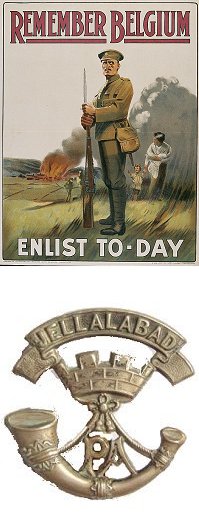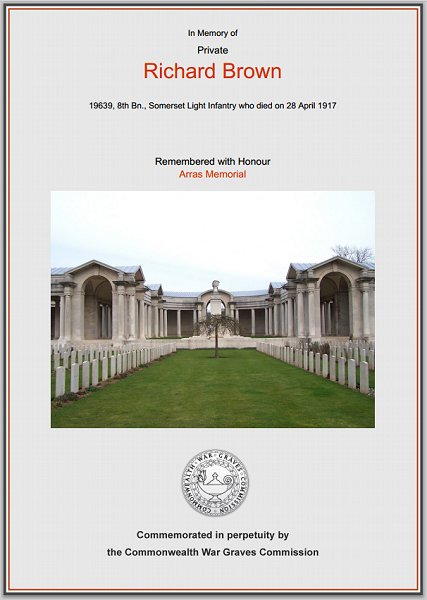yeovil at War
Richard Brown
Killed in action during the Battle of Arleux
Richard Brown was born in Stoford, just south of Yeovil in 1878. He was the son of web spinner William Reuben Brown (1854-1899) and Charity née Nichols (b 1857). In the 1881 census William and Charity were listed at Jenning's Row - a long terrace of tiny cottages, little better than slums and occupied by the very poorest families - also known as New Prospect Place, 'The Colony' and Jenning’s Buildings. In this census William and Charity's ages are given as 27 and 24 respectively - somewhat dubious since their oldest child Henry was aged 14. Nevertheless their children were Henry (b 1867 - William and Charity were married two years later), Edward (b 1870), Elias (b 1872), Reuban (b 1875), Mary J (b 1876) and three-year-old Richard.
In the 1891 census William and Charity's were somewhat more realistically given as 49 and 47 respectively. They were living at numbers 8 and 9 New Prospect Place with their children Rueben, Mary, Richard and Harriett. Richard, now aged 13, gave his occupation as an errand boy. As a sidenote, Richard's neighbour was 15-year old James Plympton who would also give his life in the Great War.
In the autumn of 1900 Richard married Mary Jane Smith at Yeovil. Richard's father had died the year before, aged 45, (and I lost track of Charity) and by the 1901 census Richard and Mary were living at 9 New Prospect Place and his older brother Henry, a hawker, was living at 8 New Prospect Place with his wife also Mary Jane. Richard gave his occupation as a mason's labourer.
Sadly, Mary died in Yeovil in 1906 aged 40, and by the 1911 census Richard was lodging with his brother Reuben and his family at 48 South Street. Richard gave his occupation as a general labourer and was working at the town gasworks.
 Richard
enlisted at
Yeovil in 1915,
joining the 8th
(Service)
Battalion of the
Somerset Light
Infantry
(Service No
19639). He was
sent to France
in 1916,
probably around
the time the
Battalion became
part of 37th
Division where
it remained on
the Western
Front for the
remainder of the
war.
Richard
enlisted at
Yeovil in 1915,
joining the 8th
(Service)
Battalion of the
Somerset Light
Infantry
(Service No
19639). He was
sent to France
in 1916,
probably around
the time the
Battalion became
part of 37th
Division where
it remained on
the Western
Front for the
remainder of the
war.
During the latter part of 1916 Richard would have served with his Battalion in the trenches of the Somme battlefield and then during 1917 took part in the Arras Offensive.
As part of the Arras Offensive the 8th Battalion took an active part in the First Battle of the Scarpe (9 to 14 April 1917), including the capture of Monchy-le-Preux, the Second Battle of the Scarpe (23 to 24 April 1917) and the Battle of Arleux (28 to 29 April 1917).
The Arras Offensive was a major British offensive during the First World War. From 9 April to 16 May 1917, troops from the four corners of the British Empire attacked trenches held by the army of Imperial Germany to the east of the French city of Arras.
Zero-Hour for the First Battle of the Scarpe had originally been planned for the morning of 8 April (Easter Sunday) but it was postponed 24 hours at the request of the French, despite reasonably good weather in the assault sector. Zero-Day was rescheduled for 9 April with Zero-Hour at 05:30. The assault was preceded by a hurricane bombardment lasting five minutes, following a relatively quiet night. When the time came, it was snowing heavily; Allied troops advancing across no man's land were hindered by large drifts. It was still dark and visibility on the battlefield was very poor. A westerly wind was at the Allied soldiers' backs blowing "a squall of sleet and snow into the faces of the Germans". The combination of the unusual bombardment and poor visibility meant many German troops were caught unawares and taken prisoner, still half-dressed, clambering out of the deep dug-outs of the first two lines of trenches. Others were captured without their boots, trying to escape but stuck in the knee-deep mud of the communication trenches. Most of the British objectives had been achieved by the evening of 10 April though the Germans were still in control of large sections of the trenches between Wancourt and Feuchy.
On 23 April, the British launched an assault east from Wancourt towards Vis-en-Artois. The British made initial gains but could advance no further east and suffered heavy losses. Farther north, German forces counter-attacked in an attempt to recapture Monchy-le-Preux, but British commanders determined not to push forward in the face of stiff German resistance, and the attack was called off the following day on 24 April.
In the Battle of Arleux (28 to 29 April 1917), although the Canadian Corps had taken Vimy Ridge, difficulties in securing the south-eastern flank had left the position vulnerable. To rectify this, British and Canadian troops launched an attack towards Arleux-en-Gohelle on 28 April. Arleux was captured by Canadian troops with relative ease, but the British troops advancing on Gavrelle met stiffer resistance from the Germans. The village was secured by early evening but, despite achieving the limited objective of securing the Canadian position on Vimy Ridge, casualties were high, and the ultimate result was disappointing. According to the Regimental History of the Somerset Light Infantry "The Battle of Arleux, fought on 28th and 29th of April, the 8th Somersets of the 37th Division again taking part in the operations, though the only Battalion of the regiment to do so. The front of attack was about 8 miles.... The attack of the XVII Corps was to be carried out by the 34th Division on the right and the 37th Division on the left.... Zero hour was 4:25am on 28 April. During the night of 27th/28th the eighth Battalion.... Moved forward from Heron Trench and assembled in Cuba Trench; the Battalion was in position by 3am on 28th, two platoons in front and two in rear, as each attacking battalion had been ordered to advance on a two-platoon frontage. It was so dark when Zero hour arrived that it was impossible to see more than 20 yards ahead, British and Germans being indistinguishable. Compass bearings had been taken and given to officers and NCOs, but even so, when the attack went forward, there was loss of direction. A few minutes after Zero a very heavy hostile barrage fell on the line of the road and the smoke, combined with the darkness, caused considerable confusion, with the result that the Somersets swung off to the left and Cuthbert Trench (directly east of Cuba Trench) was only partially attacked, the full weight of the attack passing on to Whip Trench, which lay some 500 yards east of Cuthbert."
It was during this early morning attack on 28 April 1917 that Richard was killed in action. He was 39 years old. Two other Yeovil men, Jack Bindon and Francis Sartin were killed in the same attack and died on the same day.
On 20 July 1917 the Western Gazette reported "Information has been received stating that Private R Brown, of the Somerset Light Infantry, who was reported missing some time ago, has been killed in action. Private Brown, before enlisting, was employed at the Gasworks and was 39 years of age. He had been in the army two years, out of which one was spent in France. He was very popular amongst his friends, and much sympathy is felt for the relatives."
Richard Brown is commemorated on Bay 4, Arras Memorial, Pas-de-Calais, France, and his name is recorded on the War Memorial in the Borough.
gallery

The Commonwealth War Graves Commission certificate in memory of Richard Brown.